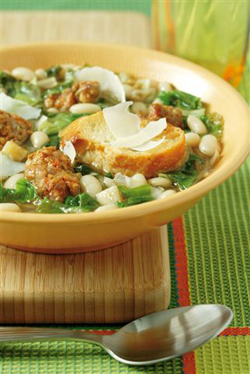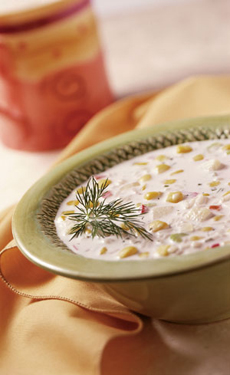
April 2010
Last Updated January 2015
|
 |
Soup Types
Become A Soup Connoisseur: Learn The Different Types Of Soup
CAPSULE REPORT: Every culture makes soup: It’s easy, filling and nutritious. Understand the differences between the soups you enjoy regularly—broth, chowder, consomme, purée and many others. This is Page 1 of a six-page article. Click on the black links below to visit other pages.
Overview
In many parts of the world, soup is a nourishing breakfast. For much of America’s history, many households served a soup course for dinner. Soup and sandwich remains a favorite American lunch. There’s even dessert soup.
In the French tradition, soups are classified into two broad groups: clear soups (bouillon and consommé) and thick soups. Most chicken soups are clear soups. Add some cream and you’ve got a cream soup, in the thick soup category.*
*Thick soups are classified depending upon the type of thickening agent used: purées are vegetable soups thickened with starch; bisques are made from puréed shellfish thickened with cream; cream soups are thickened with béchamel sauce; and veloutés are thickened with eggs, butter and cream.
When serving soup as part of a larger meal, the soup should complement the rest of the meal. A light soup complements a heavy main course (steaks, chops, stew); a heavier soup goes well with a lighter main course (pasta or grilled fish, for example).
A Brief History Of Soup
Homo sapiens, modern humans, emerged about 200,000 years ago.(1) For the majority of our existence, we have had no soup.
The earliest humans had nothing to boil water (or anything else) in. Boiling was not easy to do until the invention of waterproof containers, probably pouches made of clay or animal skin, about 9,000 years ago. According to The Star Ledger, one of the first types of soups can be dated to about 6,000 B.C.(2)
Our word soup comes from French soupe, which derived from Vulgar Latin suppa, from the post-classical Latin verb suppare, to soak. This indicated bread soaked in broth, or a liquid poured onto a piece of bread. In Germanic languages, the word sop referred to a piece of bread used to soak up soup or a thick stew. The word entered the English language in the seventeenth century exactly as that: soup pored over “sops” of bread or toast (which evolved into croutons). Prior to then, soups were called broth or pottage. The bread or toast served as an alternative to using a spoon.
|
|

Today’s soup croutons evolved from sops—pieces of bread soaked with soup. |
While the rich enjoyed elaborate soups, basic soup was a poor man’s dinner. Until recent times, the evening meal was the lighter of the two meals of the day; a soup or sop would be a typical evening dish. The name of the meal evolved to souper, than supper.
It began to be fashionable to serve the liquid broth without the sop (bread), and in the early eighteenth century, soup became a first course.(3)
Since it’s a liquid, why do we “eat” soup rather than “drink” soup? Because it’s served in a dish. If you consume it from a mug or cup, then you can be deemed to be drinking your soup.
(1) Wikipedia.
(2) Rastelli, Robert, Soup 101: First, Take An Onion, The Star-Ledger, January 12, 2005,
Savor Section, p.33.
(3) An A-Z of Food and Drink, John Ayto: Oxford University Press (2002), p.316; and Early French Cookery, D. Eleanor Scully & Terence Scully: University of Michigan Press (1995), p.102.
Continue To Next Page: Soups With A & B
Go To The Article Index Above
Lifestyle Direct, Inc. All rights reserved. Images are the copyright of their respective owners.

|





